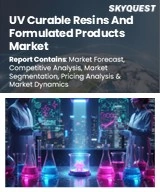
|
시장보고서
상품코드
1772404
미국의 합성 수지 시장 규모, 점유율, 동향 분석 리포트 : 형태별, 제품 유형별, 용도별, 최종 용도별, 지역별, 부문 예측(2025-2033년)U.S. Synthetic Resin Market Size, Share & Trends Analysis Report By Form (Solid, Liquid, Emulsion, Dispersion), By Product Type (Thermosetting Resin, Thermoplastic Resin), By Application, By End Use, By Region And Segment Forecasts, 2025 - 2033 |
||||||
미국의 합성 수지 시장 요약
미국의 합성 수지 시장 규모는 2024년에 808억 8,000만 달러로 추계되며, 2033년에는 1,233억 9,000만 달러에 달하며, 2025-2033년의 CAGR은 4.88%로 성장할 것으로 예측됩니다. 열 안정성과 전기 절연성이 우수한 수지에 대한 전자 산업 수요 증가가 시장 성장을 가속하고 있습니다.
이러한 고성능 소재는 더 작고 신뢰할 수 있는 장비 제조에 필수적이며, 수지 소비를 주도하고 있습니다. 미국 합성수지 시장에서는 바이오 및 지속가능한 수지 배합으로의 전환이 가속화되고 있는 것이 주요 동향입니다. 소비자와 기업의 환경 의식 향상에 힘입어 각 제조업체들은 식물성 오일, 농업 폐기물 등 재생한 자원에서 추출한 수지를 개발하기 위한 연구개발을 확대하고 있습니다. 이러한 바이오 대체 수지는 기업의 지속가능성 목표에 부합할 뿐만 아니라, 석유화학제품의 이산화탄소 배출량 감축을 위한 규제 강화에도 대응하고 있습니다.
고분자 화학의 기술 발전은 기존 석유화학 수지와 동등한 성능을 가능하게 하고, 포장 및 자동차 등 주요 최종 사용 산업에서 시장 도입을 촉진하고 있습니다. 그 결과, 시장 기업은 지속가능성을 경쟁 차별화 요소의 핵심으로 삼고 친환경 솔루션을 우선순위에 두고 제품 포트폴리오와 공급망 전략을 재구성하는 경향이 강화되고 있습니다.
성장 촉진요인, 기회, 저해요인
미국 합성수지 시장을 지원하는 주요 촉진요인은 포장 및 자동차 분야의 경량화 및 고성능 소재에 대한 수요 증가입니다. 포장 분야에서는 폴리에틸렌과 폴리프로필렌과 같은 합성수지가 특히 안전성과 유통기한 연장이 중요한 식품 및 음료 분야에서 비용 효율적이고 내구성이 뛰어나며 위생적인 솔루션에 대한 수요를 충족시키고 있습니다.
미국 합성수지 시장의 새로운 비즈니스 기회는 수지 재활용 강화와 소비자 재생(PCR) 컨텐츠의 통합을 통한 순환 경제 구상의 추진에 있습니다. 공공 자금과 민간의 지속가능성에 대한 헌신으로 지원되는 재활용 인프라에 대한 투자 확대는 성능 저하 없이 제품에 재사용할 수 있는 더 높은 품질의 재활용 수지를 가능하게 하고 있습니다. 이러한 발전은 플라스틱 폐기물과 관련된 규제 압력에 대응할 뿐만 아니라 포장, 건설 및 소비재 산업에 PCR 기반 재료를 공급함으로써 수지 제조업체에 새로운 수입원을 창출할 수 있는 기회를 열어줄 것입니다.
미국 합성수지 시장을 가로막는 중요한 요인 중 하나는 석유화학 원료 가격의 본질적인 변동이며, 이는 생산 경제와 공급망 안정성에 직접적인 영향을 미칩니다. 합성수지는 주로 석유 및 천연가스 유도체에 의존하므로 지정학적 긴장, 공급 중단, 세계 에너지 시장의 움직임에 따라 제조업체는 예측할 수 없는 비용 변동에 노출될 수 있습니다. 이러한 가격 불안정성은 특히 비용 충격을 흡수할 수 있는 규모를 갖추지 못한 소규모 생산업체의 경우 이익률을 떨어뜨릴 수 있습니다.
목차
제1장 조사 방법과 범위
제2장 개요
제3장 미국의 합성 수지 시장 변수, 동향, 범위
- 시장 계통 전망
- 모시장 전망
- 침투와 성장 전망 지도제작
- 업계 밸류체인 분석
- 주요 밸류체인 참여기업의 이익률 분석
- 원재료 동향
- 원재료 가격 분석
- 테크놀러지 개요
- 상업 생산 기술
- 기술 진보 로드맵, 2021-2030년
- 지속가능성 동향
- 재활용과 순환형 경제
- 2021-2030년의 평균 가격 동향 분석
- 가격결정에 영향을 미치는 주요 요인
- 공급 수요 갭 분석
- 규제 프레임워크
- 정책과 장려책 플랜
- 표준과 컴플라이언스
- 규제 영향 분석
- 시장 역학
- 시장 성장 촉진요인 분석
- 시장 성장 억제요인 분석
- 업계의 과제
- Porter's Five Forces 분석
- 공급업체의 힘
- 구매자의 힘
- 대체의 위협
- 신규 진출 기업으로부터의 위협
- 경쟁 기업 간 경쟁 관계
- PESTEL 분석
- 정치정세
- 경제정세
- 사회 상황
- 기술적 상황
- 환경 상황
- 법적 상황
제4장 미국의 합성 수지 시장 : 형태별 전망, 추정, 예측
- 미국의 합성 수지 시장 : 형태별 변동 분석, 2024년 및 2033년
- 고체
- 액체
- 유제
- 분산
제5장 미국의 합성 수지 시장 : 제품 유형별 전망, 추정, 예측
- 미국의 합성 수지 시장 : 제품 유형별 변동 분석, 2024년 및 2033년
- 열경화성 수지
- 열가소성 수지
제6장 미국의 합성 수지 시장 : 용도별 전망, 추정, 예측
- 미국의 합성 수지 시장 : 용도별 변동 분석, 2024년 및 2033년
- 포장
- 인쇄 잉크
- 파이프와 호스
- 시트와 필름
- 페인트와 코팅
- 접착제와 실란트
- 전자기기 제조
- 운송 부품
- 기타 애플리케이션
제7장 미국의 합성 수지 시장 : 최종 용도별 전망, 추정, 예측
- 미국의 합성 수지 시장 : 최종 용도별 변동 분석, 2024년 및 2033년
- 운송기관
- 식품 및 음료
- 퍼스널케어 & 화장품
- 건축·건설
- 석유 및 가스
- 전기·전자
- 기타 용도
제8장 경쟁 구도
- 주요 시장 참여 기업에 의한 최근 동향과 영향 분석
- 벤더 구도
- 기업 분류
- 주요 판매 대리점 및 채널 파트너 리스트
- 잠재 고객/최종사용자 리스트
- 경쟁 역학
- 기업의 시장 점유율 분석과 시장 포지셔닝
- 경쟁 벤치마킹
- 전략 지도제작
- 히트맵 분석
- 기업 개요/리스트
- 참여 기업의 개요
- 재무 실적
- 제품 벤치마킹
- Dow Inc.
- DuPont de Nemours, Inc.
- Westlake Chemical Corporation
- Hexion Inc.
- Huntsman Corporation
- Ashland Global Holdings Inc.
- Ingevity
- AOC, LLC
- Reichhold LLC
U.S. Synthetic Resin Market Summary
The U.S. synthetic resin market size was estimated at USD 80.88 billion in 2024 and is projected to reach USD 123.39 billion by 2033, growing at a CAGR of 4.88% from 2025 to 2033. Rising demand from the electronics industry for resins with superior thermal stability and electrical insulation is boosting market growth.
These high-performance materials are essential for manufacturing smaller, more reliable devices, driving resin consumption. In the U.S. Synthetic Resin Market, a prevailing trend is the accelerated shift towards bio-based and sustainable resin formulations. Fueled by heightened environmental consciousness among consumers and corporations, manufacturers are expanding R&D efforts to develop resins derived from renewable sources such as plant oils and agricultural waste. These bio-based alternatives not only align with corporate sustainability goals but also respond to evolving regulations aimed at reducing the carbon footprint of petrochemical products.
Technological advancements in polymer chemistry are enabling performance parity with traditional petrochemical resins, thereby facilitating market adoption across key end-use industries such as packaging and automotive. As a result, market players are increasingly positioning sustainability as a core competitive differentiator, reshaping product portfolios and supply chain strategies to prioritize eco-friendly solutions.
Drivers, Opportunities & Restraints
A primary driver underpinning the U.S. Synthetic Resin Market is the robust demand from the packaging and automotive sectors for lightweight, high-performance materials. In packaging, synthetic resins such as polyethylene and polypropylene cater to the need for cost-effective, durable, and hygienic solutions, particularly in food and beverage applications where safety and shelf-life extension are critical.
An emerging opportunity within the U.S. Synthetic Resin Market lies in advancing circular economy initiatives through enhanced resin recycling and the integration of post-consumer recycled (PCR) content. Growing investment in recycling infrastructure, supported by both public funding and private sustainability commitments, is enabling higher-quality recycled resins that can be reintroduced into products without significant performance compromise. This development not only addresses regulatory pressures related to plastic waste but also opens new revenue streams for resin manufacturers through the supply of PCR-based materials to packaging, construction, and consumer goods industries.
One significant restraint confronting the U.S. Synthetic Resin Market is the inherent volatility of petrochemical feedstock prices, which directly impacts production economics and supply chain stability. Synthetic resins predominantly rely on crude oil and natural gas derivatives, exposing manufacturers to unpredictable cost fluctuations driven by geopolitical tensions, supply disruptions, and global energy market dynamics. These price instabilities can erode profit margins, particularly for smaller producers lacking the scale to absorb cost shocks.
U.S. Synthetic Resin Market Report Segmentation
This report forecasts revenue growth at the country level and provides an analysis of the latest industry trends in each of the sub-segments from 2021 to 2033. For this study, Grand View Research has segmented the U.S. synthetic resin market report based on form, product type, application, and end use:
- Form Outlook (Volume, Million Tons; Revenue, USD Billion, 2021 - 2033)
- Solid
- Liquid
- Emulsion
- Dispersion
- Product Type Outlook (Volume, Million Tons; Revenue, USD Billion, 2021 - 2033)
- Thermosetting Resin
- Epoxy Resins
- Phenolic Resins
- Polyurethane Resins
- Polyester Resins
- Other Thermosetting Resin
- Thermoplastic Resin
- Polyethylene
- Polypropylene
- Polyvinyl Chloride
- Polycarbonate
- Polyethylene Terephthalate
- Nylon
- Other Thermoplastic Resin
- Application Outlook (Volume, Million Tons; Revenue, USD Billion, 2021 - 2033)
- Packaging
- Printing Inks
- Pipes & Hoses
- Sheets & Films
- Paints & Coatings
- Adhesives & Sealants
- Electronic Fabrications
- Transportation Components
- Other Applications
- End Use Outlook (Volume, Million Tons; Revenue, USD Billion, 2021 - 2033)
- Transportation
- Food & Beverage
- Personal Care & Cosmetic
- Building & Construction
- Oil & Gas
- Electrical & Electronics
- Other End Uses
Table of Contents
Chapter 1. Methodology and Scope
- 1.1. Market Segmentation & Scope
- 1.2. Market Definition
- 1.3. Information Procurement
- 1.3.1. Purchased Database
- 1.3.2. GVR's Internal Database
- 1.3.3. Secondary Types & Third-Party Perspectives
- 1.3.4. Primary Research
- 1.4. Information Analysis
- 1.4.1. Data Analysis Models
- 1.5. Market Formulation & Data Visualization
- 1.6. Data Validation & Publishing
Chapter 2. Executive Summary
- 2.1. Market Insights
- 2.2. Segmental Outlook
- 2.3. Competitive Outlook
Chapter 3. U.S. Synthetic Resin Market Variables, Trends & Scope
- 3.1. Market Lineage Outlook
- 3.1.1. Parent Market Outlook
- 3.2. Penetration & Growth Prospect Mapping
- 3.3. Industry Value Chain Analysis
- 3.3.1. Profit Margin Analysis of Key Value Chain Participants
- 3.3.2. Raw Material Trends
- 3.3.3. Raw Material Price Analysis
- 3.4. Technology Overview
- 3.4.1. Commercial Production Technology
- 3.4.2. Roadmap of Technology Advancement, 2021 to 2030
- 3.5. Sustainability Trends
- 3.5.1. Recycling and Circular Economy
- 3.6. Average Price Trend Analysis, 2021 to 2030 (USD/kg)
- 3.6.1. Key Factors Influencing Pricing
- 3.6.2. Supply Demand Gap Analysis
- 3.7. Regulatory Framework
- 3.7.1. Policies and Incentive Plans
- 3.7.2. Standards and Compliances
- 3.7.3. Regulatory Impact Analysis
- 3.8. Market Dynamics
- 3.8.1. Market Driver Analysis
- 3.8.2. Market Restraint Analysis
- 3.8.3. Industry Challenges
- 3.9. Porter's Five Forces Analysis
- 3.9.1. Supplier Power
- 3.9.2. Buyer Power
- 3.9.3. Substitution Threat
- 3.9.4. Threat from New Entrants
- 3.9.5. Competitive Rivalry
- 3.10. PESTEL Analysis
- 3.10.1. Political Landscape
- 3.10.2. Economic Landscape
- 3.10.3. Social Landscape
- 3.10.4. Technological Landscape
- 3.10.5. Environmental Landscape
- 3.10.6. Legal Landscape
Chapter 4. U.S. Synthetic Resin Market: Form Outlook Estimates & Forecasts
- 4.1. U.S. Synthetic Resin Market: Form Movement Analysis, 2024 & 2033
- 4.1.1. Solid
- 4.1.1.1. Market estimates and forecast, 2021 - 2033 (USD Billion) (Million Tons)
- 4.1.2. Liquid
- 4.1.2.1. Market estimates and forecast, 2021 - 2033 (USD Billion) (Million Tons)
- 4.1.3. Emulsion
- 4.1.3.1. Market estimates and forecast, 2021 - 2033 (USD Billion) (Million Tons)
- 4.1.4. Dispersion
- 4.1.4.1. Market estimates and forecast, 2021 - 2033 (USD Billion) (Million Tons)
- 4.1.1. Solid
Chapter 5. U.S. Synthetic Resin Market: Product Type Outlook Estimates & Forecasts
- 5.1. U.S. Synthetic Resin Market: Product Type Movement Analysis, 2024 & 2033
- 5.1.1. Thermosetting Resin
- 5.1.1.1. Market estimates and forecast, 2021 - 2033 (USD Billion) (Million Tons)
- 5.1.1.2. Epoxy Resins
- 5.1.1.2.1. Market estimates and forecast, 2021 - 2033 (USD Billion) (Million Tons)
- 5.1.1.3. Phenolic Resins
- 5.1.1.3.1. Market estimates and forecast, 2021 - 2033 (USD Billion) (Million Tons)
- 5.1.1.4. Polyurethane Resins
- 5.1.1.4.1. Market estimates and forecast, 2021 - 2033 (USD Billion) (Million Tons)
- 5.1.1.5. Polyester Resins
- 5.1.1.5.1. Market estimates and forecast, 2021 - 2033 (USD Billion) (Million Tons)
- 5.1.1.6. Other Thermosetting Resin
- 5.1.2. Thermoplastic Resin
- 5.1.2.1. Market estimates and forecast, 2021 - 2033 (USD Billion) (Million Tons)
- 5.1.2.2. Polyethylene
- 5.1.2.2.1. Market estimates and forecast, 2021 - 2033 (USD Billion) (Million Tons)
- 5.1.2.3. Polypropylene
- 5.1.2.3.1. Market estimates and forecast, 2021 - 2033 (USD Billion) (Million Tons)
- 5.1.2.4. Polyvinyl Chloride
- 5.1.2.4.1. Market estimates and forecast, 2021 - 2033 (USD Billion) (Million Tons)
- 5.1.2.5. Polycarbonate
- 5.1.2.5.1. Market estimates and forecast, 2021 - 2033 (USD Billion) (Million Tons)
- 5.1.2.6. Polyethylene Terephthalate
- 5.1.2.6.1. Market estimates and forecast, 2021 - 2033 (USD Billion) (Million Tons)
- 5.1.2.7. Nylon
- 5.1.2.7.1. Market estimates and forecast, 2021 - 2033 (USD Billion) (Million Tons)
- 5.1.2.8. Other Thermoplastic Resin
- 5.1.2.8.1. Market estimates and forecast, 2021 - 2033 (USD Billion) (Million Tons)
- 5.1.1. Thermosetting Resin
Chapter 6. U.S. Synthetic Resin Market: Application Outlook Estimates & Forecasts
- 6.1. U.S. Synthetic Resin Market: Application Movement Analysis, 2024 & 2033
- 6.1.1. Packaging
- 6.1.1.1. Market estimates and forecast, 2021 - 2033 (USD Billion) (Million Tons)
- 6.1.2. Printing Inks
- 6.1.2.1. Market estimates and forecast, 2021 - 2033 (USD Billion) (Million Tons)
- 6.1.3. Pipes & Hoses
- 6.1.3.1. Market estimates and forecast, 2021 - 2033 (USD Billion) (Million Tons)
- 6.1.4. Sheets & Films
- 6.1.4.1. Market estimates and forecast, 2021 - 2033 (USD Billion) (Million Tons)
- 6.1.5. Paints & Coatings
- 6.1.5.1. Market estimates and forecast, 2021 - 2033 (USD Billion) (Million Tons)
- 6.1.6. Adhesives & Sealants
- 6.1.6.1. Market estimates and forecast, 2021 - 2033 (USD Billion) (Million Tons)
- 6.1.7. Electronic Fabrications
- 6.1.7.1. Market estimates and forecast, 2021 - 2033 (USD Billion) (Million Tons)
- 6.1.8. Transportation Components
- 6.1.8.1. Market estimates and forecast, 2021 - 2033 (USD Billion) (Million Tons)
- 6.1.9. Other Applications
- 6.1.9.1. Market estimates and forecast, 2021 - 2033 (USD Billion) (Million Tons)
- 6.1.1. Packaging
Chapter 7. U.S. Synthetic Resin Market: End Use Outlook Estimates & Forecasts
- 7.1. U.S. Synthetic Resin Market: End Use Movement Analysis, 2024 & 2033
- 7.1.1. Transportation
- 7.1.1.1. Market estimates and forecast, 2021 - 2033 (USD Billion) (Million Tons)
- 7.1.2. Food & Beverage
- 7.1.2.1. Market estimates and forecast, 2021 - 2033 (USD Billion) (Million Tons)
- 7.1.3. Personal Care & Cosmetic
- 7.1.3.1. Market estimates and forecast, 2021 - 2033 (USD Billion) (Million Tons)
- 7.1.4. Building & Construction
- 7.1.4.1. Market estimates and forecast, 2021 - 2033 (USD Billion) (Million Tons)
- 7.1.5. Oil & Gas
- 7.1.5.1. Market estimates and forecast, 2021 - 2033 (USD Billion) (Million Tons)
- 7.1.6. Electrical & Electronics
- 7.1.6.1. Market estimates and forecast, 2021 - 2033 (USD Billion) (Million Tons)
- 7.1.7. Other End Uses
- 7.1.7.1. Market estimates and forecast, 2021 - 2033 (USD Billion) (Million Tons)
- 7.1.1. Transportation
Chapter 8. Competitive Landscape
- 8.1. Recent Developments & Impact Analysis, By Key Market Participants
- 8.2. Vendor Landscape
- 8.2.1. Company categorization
- 8.2.2. List of Key Distributors and Channel Partners
- 8.2.3. List of Potential Customers/End-users
- 8.3. Competitive Dynamics
- 8.3.1. Company Market Share Analysis & Market Positioning
- 8.3.2. Competitive Benchmarking
- 8.3.3. Strategy Mapping
- 8.3.4. Heat Map Analysis
- 8.4. Company Profiles/Listing
- 8.4.1. Participant's overview
- 8.4.2. Financial performance
- 8.4.3. Product benchmarking
- 8.4.3.1. Dow Inc.
- 8.4.3.2. DuPont de Nemours, Inc.
- 8.4.3.3. Westlake Chemical Corporation
- 8.4.3.4. Hexion Inc.
- 8.4.3.5. Huntsman Corporation
- 8.4.3.6. Ashland Global Holdings Inc.
- 8.4.3.7. Ingevity
- 8.4.3.8. AOC, LLC
- 8.4.3.9. Reichhold LLC
(주말 및 공휴일 제외)


















